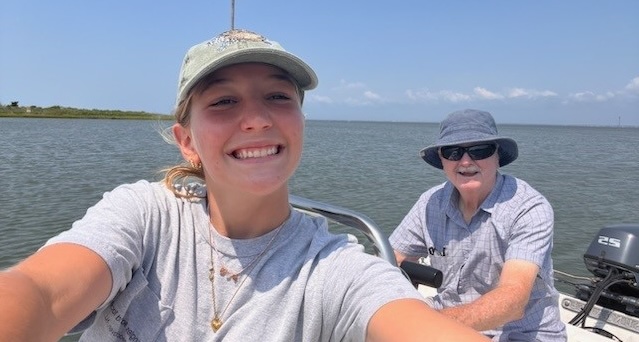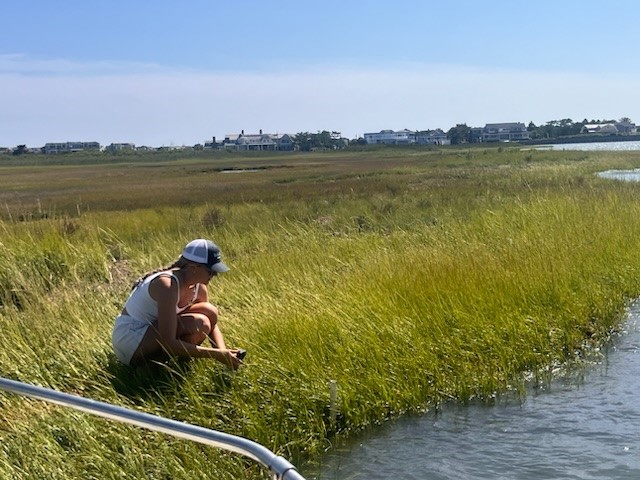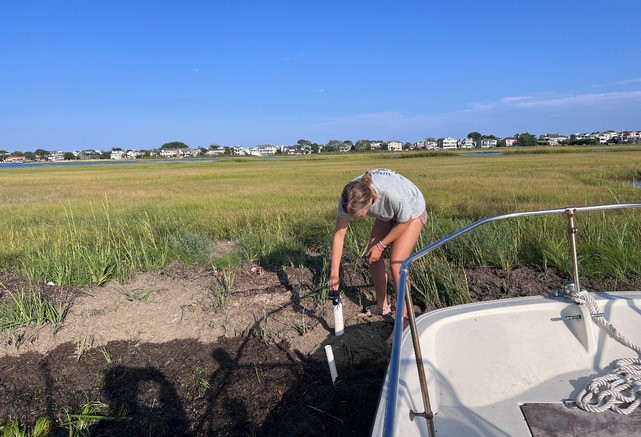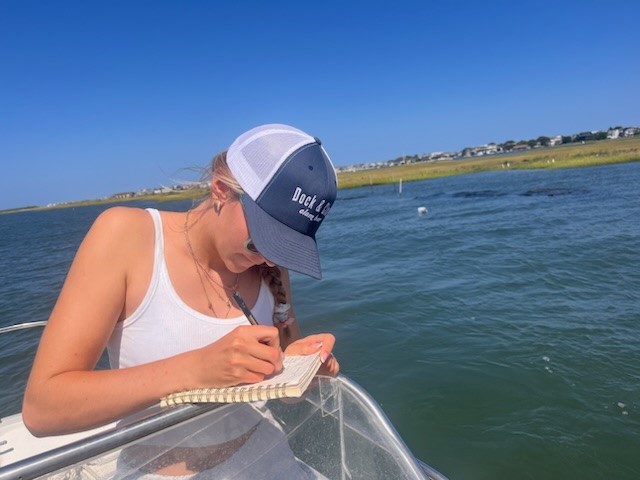For many people, summers on the Jersey Shore are about sun, sand, and surf. But for high school student Nora Morton, the Jersey Shore is more than just a vacation destination—it’s where her love for the environment began. Growing up boating, kayaking, fishing, and exploring the marshes of Barnegat Bay, Nora developed a deep connection to the natural ecosystems that shaped her childhood and influenced her perspective on both the beauty and fragility of coastal environments. Now, as a young scientist, she’s using that passion to help protect these fragile environments through her WILSON project. WILSON is a research project aimed at tackling one of the region’s growing challenges: the effects of boat wakes on eroding shorelines.

In this article, we delve into her journey, which merges her love for the environment with her groundbreaking WILSON research project and its potential impact on protecting bay islands and coastal communities. Nora’s work is a testament to how individuals can contribute to larger conservation efforts, combining innovative technology with community-driven solutions to safeguard coastal areas.
The Jersey Shore: A Source of Passion and Curiosity
Nora’s love for the Jersey Shore goes beyond typical beach days. When asked about her favorite summer memories, it’s clear that her connection to the water runs deep. She fondly recalls learning to drive a boat, paddling through the waters in her kayak, and wandering the salt marshes of islands in the bay. These experiences, she says, nurtured her curiosity about coastal ecology and instilled a deep desire to protect these environments.
“I have so many memories of being on the water with my family in the summer. It made me realize just how much I loved these ecosystems,” Nora shares. It wasn’t just the summer months that captured her attention. Even during the colder seasons, she cherishes her family’s tradition of New Year’s Day walks along the beach, marveling at the ever-changing landscape.
While beach days on Long Beach Island are still a central part of her summer routine, her interests have grown. Recent summers have seen her balancing a summer job, pursuing her love of painting and drawing, and collecting data for her research. But one thing hasn’t changed: the shore’s unique appeal. “I love learning about coastal ecology and exploring the muddy marshes of Barnegat Bay,” she says. Her fascination with coastal environments led her to explore ways to protect these fragile ecosystems, particularly as rising seas and increased human activity put them at risk. For this young scientist, the shore has become much more—a living laboratory where she can combine personal passion with scientific inquiry.
Finding Her Path: The Horace Greeley Science Research Program
Nora attends Horace Greeley High School in Chappaqua, NY. Her participation in the Horace Greeley Science Research Program allowed her to turn her passion into action. The Horace Greeley Science Research Program initiative encourages students to dive deep into scientific fields throughout their 4 years of high school, connect with experts in their particular field of interest, and develop a research project. “I’ve always had a love for science,” she explained, “and this program was a way for me to connect my passion for protecting the bay with my research project.” At first, she wasn’t sure exactly what her research project would be. “I had a lot of ideas—from a trawl survey to observing boater behavior near marsh islands—but I eventually landed on the idea of the WILSON project with my mentor’s guidance.”
“I met Mr. Dugan through the New Jersey Bay Islands Initiative,” she said. “He taught me a lot about coastal engineering and conservation, and his creativity and determination have helped me grow as a scientist.” Under the mentorship of Jim Dugan, Vice President of the Mordecai Land Trust, Nora developed WILSON (Wave Intensity Logging Sensor Of Nora)—a project that uses smartphone technology to measure the effects of boat wakes on Barnegat Bay’s small islands. Mr. Dugan initially suggested, “how about we put an iPhone inside a volleyball and see what it picks up.” Nora conjured the image of “Wilson” from the movie Castaway, and she created the funny acronym. Although she didn’t end up using a volleyball, she did use smartphone technology embedded in a floatable waterproof jug. The WILSON project represents a crucial intersection between low-cost scientific research and community engagement, a theme that’s central to the work of the New Jersey Bay Islands Initiative (NJBII). Together with Jim and the NJBII, Nora was able to bring her passion for coastal resilience to life through her WILSON project.
The New Jersey Bay Island Initiative: A Framework for Nora’s Research

The New Jersey Bay Island Initiative (NJBII) was launched to address the growing threats faced by the bay islands, which act as natural barriers protecting coastal communities from storm surges, rising sea levels, and flooding. NJBII’s mission is to preserve and restore these islands, which are critical for both wildlife habitat and human safety. The initiative focuses on a multi-faceted approach, combining shoreline restoration, erosion control, and community engagement to create sustainable solutions for the islands.
Nora’s WILSON project is inspired by these objectives, particularly the emphasis on protecting the islands from erosion. Her research investigates how boat wakes contribute to the erosion of the bay islands, making it harder for them to act as natural defenses against coastal storms.
Why boat wakes? “Boat traffic has a major impact on the erosion of bay islands, which act as natural barriers to storm surges and rising seas,” she explains. As she discussed on the America Adapts podcast (listen to Nora’s interview at about 1:29), coastal resilience is becoming increasingly important as climate change leads to more extreme weather and rising sea levels. Protecting these small islands can help shield inland communities from the worst effects of storms and flooding. “Boat traffic has a major impact on the erosion of these islands,” Nora explains. “By studying how boat wakes affect wave energy, we can find better ways to protect the islands from further damage.”
Harnessing Technology for Science: The Role of Data Collecting Apps
At the heart of WILSON is a simple but powerful idea: use readily available technology to gather important environmental data. One key component of the WILSON project has been the use of data-collecting apps to measure boat wakes. After experimenting with various apps, she landed on an app called Sensor Log, which uses a smartphone’s accelerometer to record and process wave activity. “It’s accessible, reliable, and can stream data from a smartphone to a computer,” she explained.
The data collected, however, required more than just raw numbers. “The app gave me acceleration data, but I had to process it into displacement or wave height. To do this, I needed to take the integral of the data twice, once to get velocity and then again to get displacement.”
She accomplished this with help from another mentor, Dr. Jennifer Field, who taught her how to convert the raw data into usable information that could track the impact of boat wakes on bay island shorelines. She learned to write code in MATLAB to analyze the data. This work has led her to a promising conclusion: “The data has shown me that a smartphone’s accelerometer can be used to measure boat wakes accurately, which is a huge step for coastal resilience research.”

This breakthrough opens the door to more accessible, low-cost monitoring for coastal communities, a vital step in protecting fragile ecosystems. The WILSON project is groundbreaking because it allows Nora to measure wave height using readily available technology. This discovery opens up new possibilities for low-cost, community-driven monitoring of coastal environments. Her work is particularly relevant to coastal resilience efforts, as the erosion of bay islands directly affects the natural barriers that protect inland communities from storms and rising waters. Such data is critical for understanding the long-term effects of human activity on fragile ecosystems like the bay islands.
Innovating for Coastal Resilience
One of the most significant aspects of Nora’s work is its potential to contribute to broader coastal resilience efforts. By testing the efficacy of breakwater structures in attenuating boat wakes, Nora’s research could provide valuable insights into how these structures can help protect the islands from erosion. This directly supports the NJBII’s objective to explore sustainable, nature-based solutions for shoreline protection.
Nora’s use of smartphone technology also opens up new possibilities for community involvement. “I wanted to create something that anyone could use to collect data,” she says. By making scientific tools more accessible, Nora’s project encourages local communities to engage with coastal resilience efforts in a hands-on way, further amplifying the goals of the NJBII.
Continuing the Mission: The Future of WILSON and Coastal Conservation

WILSON isn’t just a one-time project. Nora continued using WILSON for a second summer of research. “I’m testing different breakwater structures to see how well they can attenuate boat wakes,” she shared enthusiastically. “I also plan to teach more people how to replicate my procedures and make their own WILSONs.”
Her aspirations go even further. “I’m interested in using machine learning to analyze the data more efficiently and applying this method to other parameters, like wave direction,” she explains. “There’s so much more to explore in this field.” The potential applications of WILSON are broad, from studying the effects of climate change to helping coastal communities better prepare for future challenges.
A Vision for the Future
This young scientist’s journey from carefree summers on the Jersey Shore to the forefront of coastal resilience research shows how passion, creativity, and mentorship can combine to make a real impact. Nora’s future plans include studying marine science in college, but she also wants to continue her work with coastal resilience. “I definitely want to stay connected to the Jersey Shore and do more to protect it,” she says. Coastal resilience and community-driven solutions are key strategies for addressing the challenges posed by climate change. and preserving the shoreline she loves so much.
Her WILSON project, inspired by the goals of the New Jersey Bay Island Initiative and informed by the latest discussions in coastal resilience, stands as a beacon of hope in the fight against climate change. By combining accessible technology with scientific inquiry, Nora is not only advancing research but also empowering local communities to play an active role in preserving the coastlines they depend on.
Nora’s work is a hopeful sign that the next generation is ready to take on the task of preserving our coastlines. Nora Morton is proving that young people have a crucial role to play in safeguarding the environment, one innovative project at a time.
